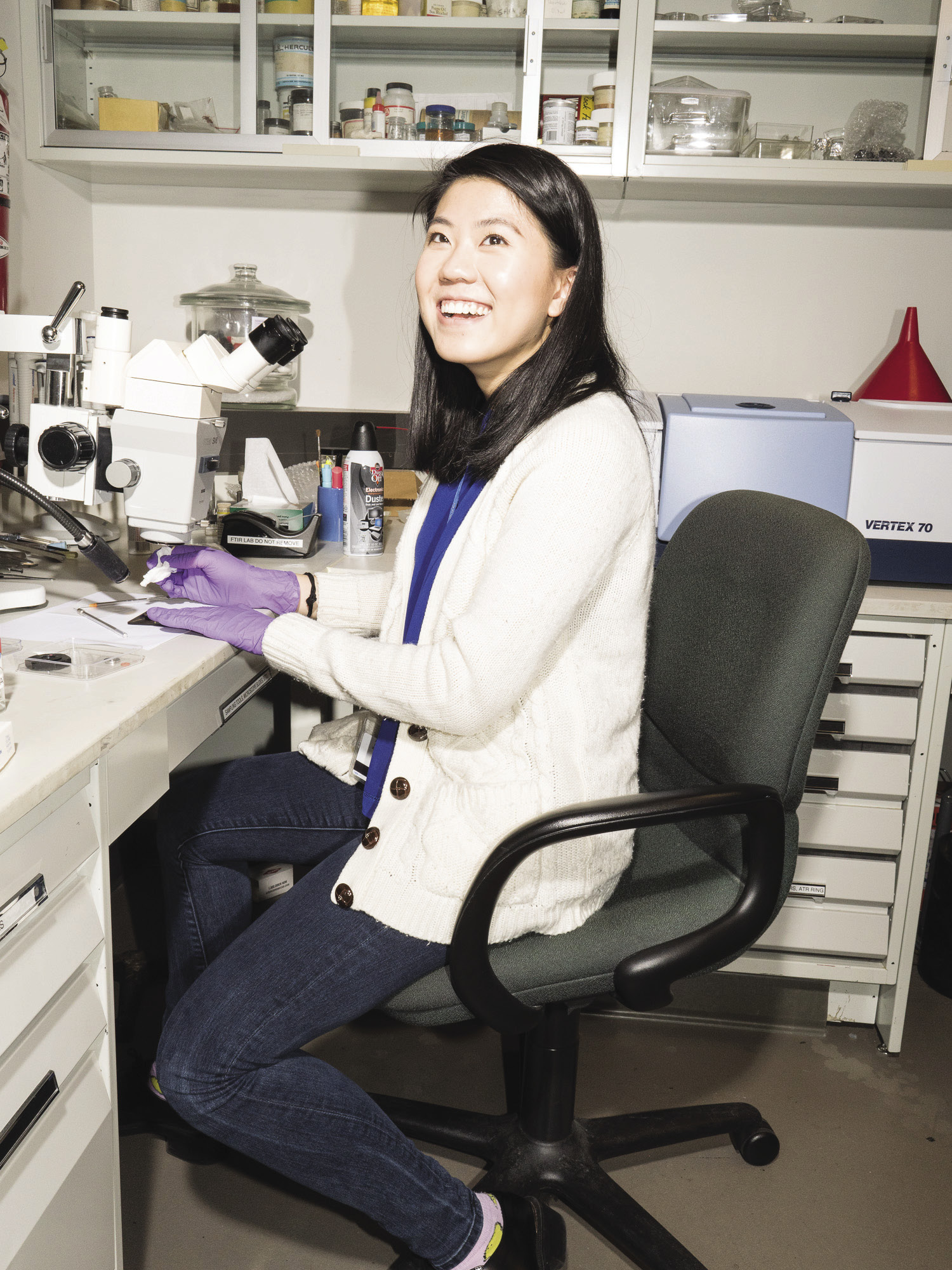Just a floor below the grand masterpieces and the frenzy of tourists at the Metropolitan Museum of Art, Choi Mak ’18 sits in a small lab outfitted with expensive microscopes, tiny vials, and binders of reference materials. Mak, who has been an intern at the Met since the summer of 2015, is solving puzzles—mysteries of chemistry, color, and culture.
Under a microscope, she examines a minute paint chip that has been extracted from a plaster ceiling in one of the Met’s “period rooms,” a re-creation of the tapestry room at Croome Court, the stately home of a British earl. Mak’s assignment is to analyze a cross section of the paint chip to determine the color when it was first applied in the 18th century. If the color is found to be markedly different from the current one, the ceiling will be repainted.
Mak is one of several students who have participated in an internship program that offers hands-on access to some of the world’s rarest artworks and an opportunity to participate in complex research that answers important questions about the provenance, age, and chemical composition of art. The interns, who perform their tasks alongside scientists, conservators, and curators in the Met’s conservation science program, get an up-close view of how science and art intersect to unravel centuries-old mysteries.
The internship has been an ideal opportunity for Mak, a chemistry major on the road to a possible career in conservation science. This fall, she will focus her studies on art history when she spends a semester at University College London.

“When you’re in a lab class, the goal is very straightforward, and there are instructions to guide you,” Mak says. At the museum, solving chemistry problems can be more challenging—and sometimes frustrating—but finding the solution, she says, is more gratifying: “It’s a real application of chemistry.” Mak has used leaves, nuts, and other plant materials from around Sicily to try to replicate inks from medieval ivory carvings.
The program was created in 2010 by Peter Bower, a senior lecturer in Barnard’s Department of Environmental Science, whose untraditional career path includes stints as mayor of Teaneck, N.J. and as a preschool teacher. Bower’s expertise is in stone conservation, and he teaches a favorite course that focuses on the provenance of materials.
The Met internship “is detective work,” he says. “The students work on a long-term problem that requires weeks and months of effort. They’re in the library trying to find ancient documents. They end up in a lot of places besides the lab. They must talk to many researchers—often from around the world—and gather evidence from other museums. It’s an interdisciplinary exercise that includes art, history, and science.”
Recent interns have carried out their projects with the Met’s associate research scientist Adriana Rizzo, who says she has been impressed by the students’ “resourcefulness and talent.” The experience is not only invaluable for the students, but beneficial for the museum, she adds.
The Met internship “is detective work”. The students “must talk to many researchers—often from around the world—and gather evidence from other museums. It’s an interdisciplinary exercise that includes art, history, and science.”
Peter Bower, creator of the program and a senior lecturer in Barnard’s Department of Environmental Science
For Ashley Krauss ’11, the program offered a once-in-a-lifetime experience: She was hoisted 60 feet in the air in the basket of a cherry picker to examine Cleopatra’s Needle, an Egyptian obelisk created in 1450 B.C. and now located behind the museum in Central Park. From her perch, she spent an hour taking notes on the condition of its surface as part of a project to determine how to better protect it from corrosion.
She reveled in the splendor of the setting and the view of the Met from the cherry picker, but was distressed by the state of the obelisk, which had weathered more severely than its mate in London. Both were gifts from Egypt that were installed in their respective cities within two years of each other in the late 19th century. She determined that historical events, environmental factors, and earlier conservation efforts had all played a role in the New York obelisk’s decay.
In May, Krauss earned a master’s degree in archeology from Yale and recently began working as a geophysical archeologist. “It’s only because of the internship that I really had the opportunity to identify my passion for archeology and archeological conservation,” she says.
Students receive a stipend for the internship thanks, in part, to the support of Valerie Colas-Ohrstrom ’94, one of Bower’s former students, as well as the Patrina Foundation.
Meghan Schwab ’16, who was a Met intern for a year, helped clean a mosaic floor from the second century that had been displayed in the museum’s Greek and Roman wing. She helped analyze scrapings from the floor under a microscope, discovering that beeswax had once covered it. As she cleaned the floor with stiff paintbrushes and solvents, Schwab was awestruck by touching such an ancient artwork: “I can’t even imagine the people who had been walking on it.”
Schwab arrived at Barnard with a passion for both science and art, and had worried she would need to choose between them. She didn’t imagine having the opportunity to integrate both subjects while she was behind the scenes at one of the nation’s premier museums: “It’s so rare that students get to do this.”
